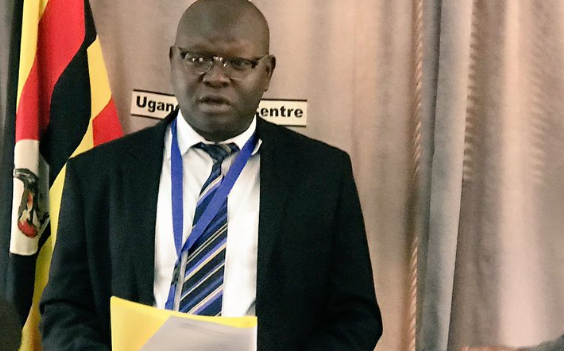Ministry of Health’s war on new Malaria infections in Uganda dubbed ‘Chase Malaria – Sleep Under a Mosquito Net’ will now shift focus to commencement of the distribution process for Kampala and Wakiso districts.
While addressing a Press Conference in Kampala on Wednesday, National Malaria Control Program Manager, Dr. Opigo Jimmy (pictured above) said registration of households in Wakiso district will be in the second week of December 2017 and later distribution will take place in the second week of February 2018.

One of the strategies for prevention of Malaria, Uganda is currently undertaking the second Universal Coverage Campaign for the distribution of mosquito nets. This intervention is intended to reduce mortality and morbidity of Malaria, which is still the single largest killer disease in Uganda.
Dr. Opigo said distribution was accompanied by massive sensitization on proper use of nets while resistant communities were sensitized on how to hang nets and net usage.
Health minister, Jane Aceng, says the prevalence rates have further dropped, with Kampala, the capital city, registering the lowest prevalence countrywide, at one per cent.
The Campaign commenced in February with the official launch in Apac district. The country was divided into six waves with the first wave covering 27 districts in northern Uganda and West Nile. During this wave, a total of 4,175,735 nets were distributed hence protecting over 8 million people. So far, a total of 17,516,859 number of nets have been distributed under wave 2, 3, 4 and 5 hence protecting over 38 million people.
Despite the national prevalence declining from 42 per cent in 2009 to 19 per cent in 2015, the disease remains the leading cause of death and patient- admissions in most health facilities around the country.
Because the mosquito seems to be clawing back — latest data from the country’s annual health sector performance report indicates that the number of malaria cases per 1,000 persons increased to 433 in the financial year 2016/17, from 408 in 2015/16, way above the Health Sector Development Plan target of 329 per 1,000 — the government is, you guessed it right, again, ramping up the supply of treated bed nets.
Dr. Opigo says infection rates can further be prevented by stricter vector control, chemoprevention (providing drugs that suppress infection) or, potentially, by vaccination.
Currently, 90 per cent of the households in Uganda own at least one mosquito net, compared with 47 per cent in 2009. The percentage of children who slept under an insecticide-treated net before the night of the survey increased from 33 to 74 per cent, while for pregnant women it increased from 44 to 75 per cent.











